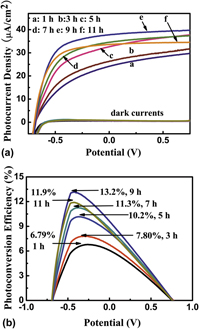Crossref Citations
This article has been cited by the following publications. This list is generated based on data provided by
Crossref.
Haring, Andrew
Morris, Amanda
and
Hu, Michael
2012.
Controlling Morphological Parameters of Anodized Titania Nanotubes for Optimized Solar Energy Applications.
Materials,
Vol. 5,
Issue. 10,
p.
1890.
Li, Na
Pan, Nengqian
Li, Danhong
and
Lin, Shiwei
2013.
Natural Dye-Sensitized Solar Cells Based on Highly Ordered TiO2Nanotube Arrays.
International Journal of Photoenergy,
Vol. 2013,
Issue. ,
p.
1.
Li, Danhong
Pan, Nengqian
Liao, Jianjun
Cao, Xiankun
and
Lin, Shiwei
2013.
Effects of Surface Modification of Nanotube Arrays on the Performance of CdS Quantum-Dot-Sensitized Solar Cells.
International Journal of Photoenergy,
Vol. 2013,
Issue. ,
p.
1.
Zhang, Li
Pan, Nengqian
and
Lin, Shiwei
2014.
Influence of Pt deposition on water-splitting hydrogen generation by highly-ordered TiO2 nanotube arrays.
International Journal of Hydrogen Energy,
Vol. 39,
Issue. 25,
p.
13474.
Joseph, Shibu
and
Sagayaraj, Pappu
2015.
A cost effective approach for developing substrate stable TiO2nanotube arrays with tuned morphology: a comprehensive study on the role of H2O2and anodization potential.
New Journal of Chemistry,
Vol. 39,
Issue. 7,
p.
5402.
Zeng, Min
Peng, Xiange
Liao, Jianjun
Wang, Guizhen
Li, Yanfang
Li, Jianbao
Qin, Yong
Wilson, Joshua
Song, Aimin
and
Lin, Shiwei
2016.
Enhanced photoelectrochemical performance of quantum dot-sensitized TiO2 nanotube arrays with Al2O3 overcoating by atomic layer deposition.
Physical Chemistry Chemical Physics,
Vol. 18,
Issue. 26,
p.
17404.
Subramaniam, M. N.
Goh, P. S.
Abdullah, N.
Lau, W. J.
Ng, B. C.
and
Ismail, A. F.
2017.
Adsorption and photocatalytic degradation of methylene blue using high surface area titanate nanotubes (TNT) synthesized via hydrothermal method.
Journal of Nanoparticle Research,
Vol. 19,
Issue. 6,
Zhou, Quan
Zhou, Junchen
Zeng, Min
Wang, Guizhen
Chen, Yongjun
and
Lin, Shiwei
2017.
Photoelectrochemical Performance of Quantum dot-Sensitized TiO2 Nanotube Arrays: a Study of Surface Modification by Atomic Layer Deposition Coating.
Nanoscale Research Letters,
Vol. 12,
Issue. 1,
Wan, Yingqi
Xu, Aoni
Dong, Chaofang
He, Chang
Xiao, Kui
Tian, Yuwan
and
Li, Xiaogang
2018.
Co/Mn co-doped TiO2 nanotube arrays for enhanced photoelectrochemical properties: experimental and DFT investigations.
Journal of Materials Science,
Vol. 53,
Issue. 14,
p.
9988.
Yang, Liang
Wang, Cai-Zhuang
Lin, Shiwei
Chen, Taohai
Cao, Yang
Zhang, Ping
and
Liu, Xiaoheng
2019.
Thermal conductivity of TiO2 nanotube: a molecular dynamics study.
Journal of Physics: Condensed Matter,
Vol. 31,
Issue. 5,
p.
055302.
Ai, Changzhi
Xie, Pengcheng
Zhang, Xidong
Zheng, Xusheng
Li, Jin
Kafizas, Andreas
and
Lin, Shiwei
2019.
Explaining the Enhanced Photoelectrochemical Behavior of Highly Ordered TiO2 Nanotube Arrays: Anatase/Rutile Phase Junction.
ACS Sustainable Chemistry & Engineering,
Vol. 7,
Issue. 5,
p.
5274.
Nie, Xiaojiang
Wang, Junkun
Duan, Wenchao
Zhao, Zilong
Li, Liang
and
Zhang, Zhiqiang
2021.
Effects of different crystallization methods on photocatalytic performance of TiO2 nanotubes.
Applied Physics A,
Vol. 127,
Issue. 11,
Nie, Xiaojiang
Wang, Junkun
Duan, Wenchao
Zhao, Zilong
Li, Liang
and
Zhang, Zhiqiang
2021.
One-step preparation of C-doped TiO2 nanotubes with enhanced photocatalytic activity by a water-assisted method.
CrystEngComm,
Vol. 23,
Issue. 16,
p.
3015.
Nie, Xiaojiang
Yin, Siqi
Duan, Wenchao
Zhao, Zilong
Li, Liang
and
Zhang, Zhiqiang
2021.
Recent Progress in Anodic Oxidation of TiO2 Nanotubes and Enhanced Photocatalytic Performance: A Short Review.
Nano,
Vol. 16,
Issue. 01,
p.
2130002.
Yılmaz, Ozan
Ebeoglugil, Faruk
Demirci, Selim
and
Dikici, Tuncay
2022.
Influence of electrolyte composition on the microstructure and photocatalytic activity of TiO2 nanostructures.
Journal of the Australian Ceramic Society,
Vol. 58,
Issue. 1,
p.
123.





